Logistics and Supply Chain Management of Toyota Motor Corporation
VerifiedAdded on 2023/06/10
|10
|2748
|170
AI Summary
This report focuses on the relationship between supply chain management and logistics management of Toyota Motor Corporation. It also analyses the effectiveness of ERP in enhancing organizational efficiency and provides recommendations to increase reliability in supply chain and logistics.
Contribute Materials
Your contribution can guide someone’s learning journey. Share your
documents today.
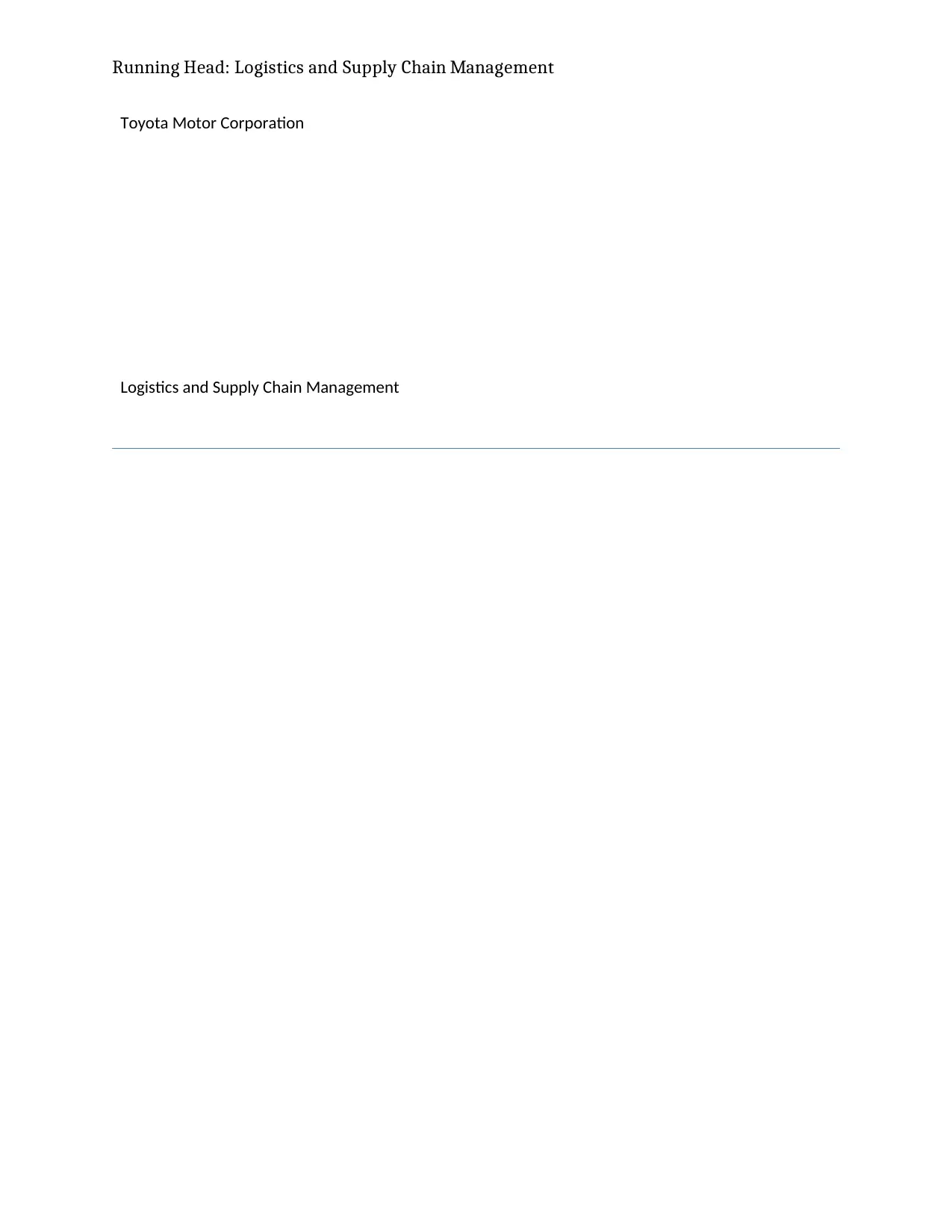
Running Head: Logistics and Supply Chain Management
Toyota Motor Corporation
Logistics and Supply Chain Management
Toyota Motor Corporation
Logistics and Supply Chain Management
Secure Best Marks with AI Grader
Need help grading? Try our AI Grader for instant feedback on your assignments.

Logistics and Supply Chain Management 1 | P a g e
Table of Contents
Introduction......................................................................................................................................2
Relationship between Supply Chain Management and Logistics Management..............................2
Difference between logistics management and supply chain management.................................3
Enterprise Resource Planning (ERP)...............................................................................................4
Recommendations to increase reliability in supply chain and logistics..........................................5
Conclusion.......................................................................................................................................6
References........................................................................................................................................7
Table of Contents
Introduction......................................................................................................................................2
Relationship between Supply Chain Management and Logistics Management..............................2
Difference between logistics management and supply chain management.................................3
Enterprise Resource Planning (ERP)...............................................................................................4
Recommendations to increase reliability in supply chain and logistics..........................................5
Conclusion.......................................................................................................................................6
References........................................................................................................................................7
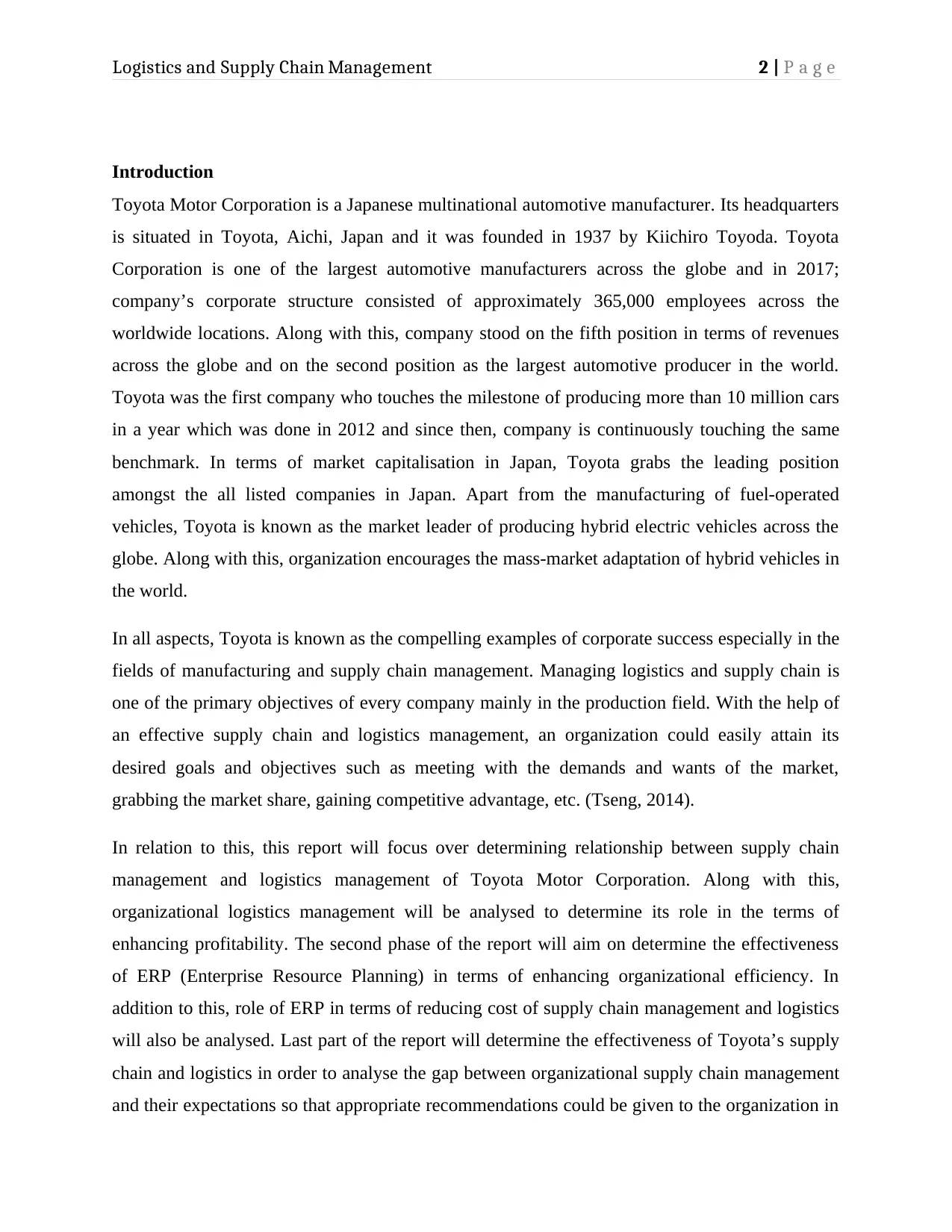
Logistics and Supply Chain Management 2 | P a g e
Introduction
Toyota Motor Corporation is a Japanese multinational automotive manufacturer. Its headquarters
is situated in Toyota, Aichi, Japan and it was founded in 1937 by Kiichiro Toyoda. Toyota
Corporation is one of the largest automotive manufacturers across the globe and in 2017;
company’s corporate structure consisted of approximately 365,000 employees across the
worldwide locations. Along with this, company stood on the fifth position in terms of revenues
across the globe and on the second position as the largest automotive producer in the world.
Toyota was the first company who touches the milestone of producing more than 10 million cars
in a year which was done in 2012 and since then, company is continuously touching the same
benchmark. In terms of market capitalisation in Japan, Toyota grabs the leading position
amongst the all listed companies in Japan. Apart from the manufacturing of fuel-operated
vehicles, Toyota is known as the market leader of producing hybrid electric vehicles across the
globe. Along with this, organization encourages the mass-market adaptation of hybrid vehicles in
the world.
In all aspects, Toyota is known as the compelling examples of corporate success especially in the
fields of manufacturing and supply chain management. Managing logistics and supply chain is
one of the primary objectives of every company mainly in the production field. With the help of
an effective supply chain and logistics management, an organization could easily attain its
desired goals and objectives such as meeting with the demands and wants of the market,
grabbing the market share, gaining competitive advantage, etc. (Tseng, 2014).
In relation to this, this report will focus over determining relationship between supply chain
management and logistics management of Toyota Motor Corporation. Along with this,
organizational logistics management will be analysed to determine its role in the terms of
enhancing profitability. The second phase of the report will aim on determine the effectiveness
of ERP (Enterprise Resource Planning) in terms of enhancing organizational efficiency. In
addition to this, role of ERP in terms of reducing cost of supply chain management and logistics
will also be analysed. Last part of the report will determine the effectiveness of Toyota’s supply
chain and logistics in order to analyse the gap between organizational supply chain management
and their expectations so that appropriate recommendations could be given to the organization in
Introduction
Toyota Motor Corporation is a Japanese multinational automotive manufacturer. Its headquarters
is situated in Toyota, Aichi, Japan and it was founded in 1937 by Kiichiro Toyoda. Toyota
Corporation is one of the largest automotive manufacturers across the globe and in 2017;
company’s corporate structure consisted of approximately 365,000 employees across the
worldwide locations. Along with this, company stood on the fifth position in terms of revenues
across the globe and on the second position as the largest automotive producer in the world.
Toyota was the first company who touches the milestone of producing more than 10 million cars
in a year which was done in 2012 and since then, company is continuously touching the same
benchmark. In terms of market capitalisation in Japan, Toyota grabs the leading position
amongst the all listed companies in Japan. Apart from the manufacturing of fuel-operated
vehicles, Toyota is known as the market leader of producing hybrid electric vehicles across the
globe. Along with this, organization encourages the mass-market adaptation of hybrid vehicles in
the world.
In all aspects, Toyota is known as the compelling examples of corporate success especially in the
fields of manufacturing and supply chain management. Managing logistics and supply chain is
one of the primary objectives of every company mainly in the production field. With the help of
an effective supply chain and logistics management, an organization could easily attain its
desired goals and objectives such as meeting with the demands and wants of the market,
grabbing the market share, gaining competitive advantage, etc. (Tseng, 2014).
In relation to this, this report will focus over determining relationship between supply chain
management and logistics management of Toyota Motor Corporation. Along with this,
organizational logistics management will be analysed to determine its role in the terms of
enhancing profitability. The second phase of the report will aim on determine the effectiveness
of ERP (Enterprise Resource Planning) in terms of enhancing organizational efficiency. In
addition to this, role of ERP in terms of reducing cost of supply chain management and logistics
will also be analysed. Last part of the report will determine the effectiveness of Toyota’s supply
chain and logistics in order to analyse the gap between organizational supply chain management
and their expectations so that appropriate recommendations could be given to the organization in
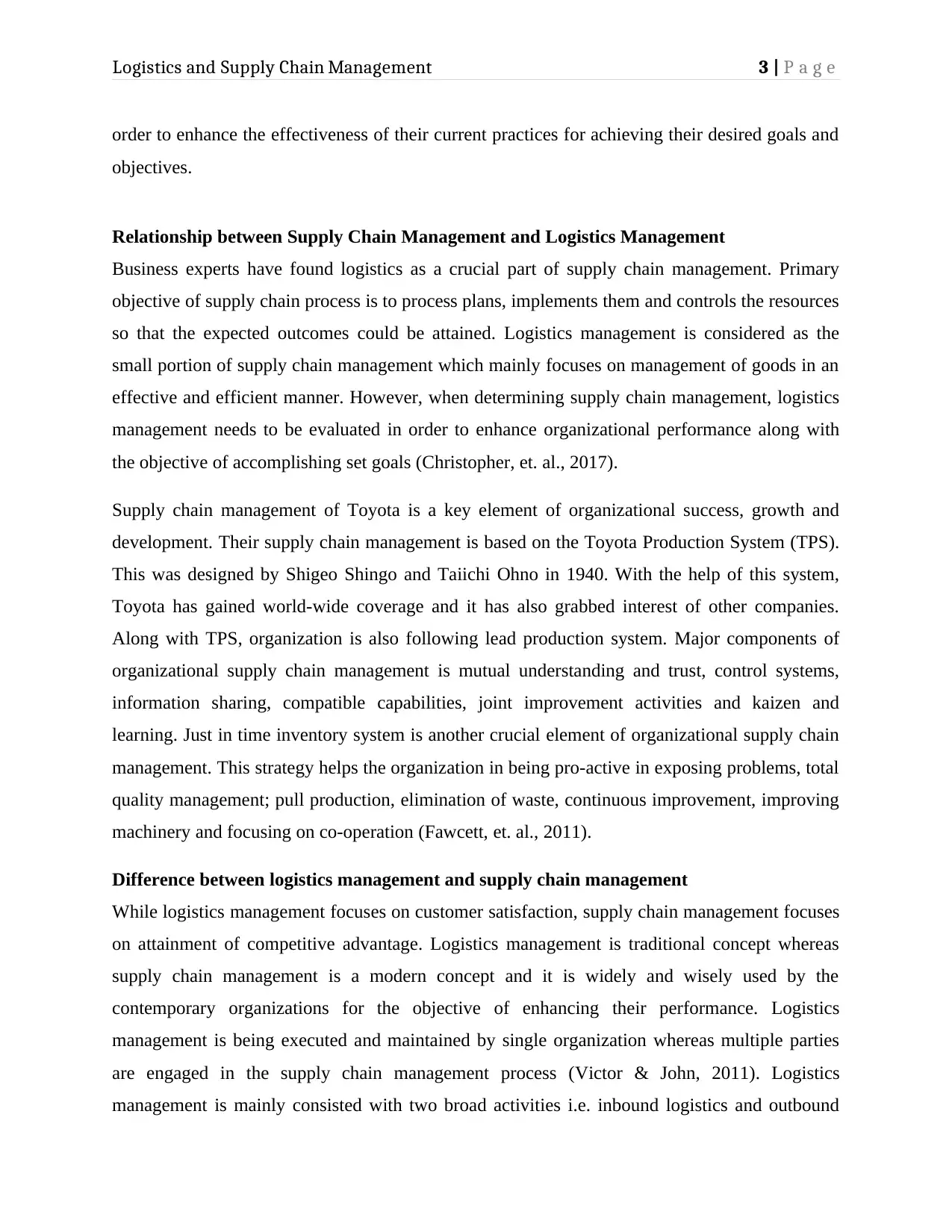
Logistics and Supply Chain Management 3 | P a g e
order to enhance the effectiveness of their current practices for achieving their desired goals and
objectives.
Relationship between Supply Chain Management and Logistics Management
Business experts have found logistics as a crucial part of supply chain management. Primary
objective of supply chain process is to process plans, implements them and controls the resources
so that the expected outcomes could be attained. Logistics management is considered as the
small portion of supply chain management which mainly focuses on management of goods in an
effective and efficient manner. However, when determining supply chain management, logistics
management needs to be evaluated in order to enhance organizational performance along with
the objective of accomplishing set goals (Christopher, et. al., 2017).
Supply chain management of Toyota is a key element of organizational success, growth and
development. Their supply chain management is based on the Toyota Production System (TPS).
This was designed by Shigeo Shingo and Taiichi Ohno in 1940. With the help of this system,
Toyota has gained world-wide coverage and it has also grabbed interest of other companies.
Along with TPS, organization is also following lead production system. Major components of
organizational supply chain management is mutual understanding and trust, control systems,
information sharing, compatible capabilities, joint improvement activities and kaizen and
learning. Just in time inventory system is another crucial element of organizational supply chain
management. This strategy helps the organization in being pro-active in exposing problems, total
quality management; pull production, elimination of waste, continuous improvement, improving
machinery and focusing on co-operation (Fawcett, et. al., 2011).
Difference between logistics management and supply chain management
While logistics management focuses on customer satisfaction, supply chain management focuses
on attainment of competitive advantage. Logistics management is traditional concept whereas
supply chain management is a modern concept and it is widely and wisely used by the
contemporary organizations for the objective of enhancing their performance. Logistics
management is being executed and maintained by single organization whereas multiple parties
are engaged in the supply chain management process (Victor & John, 2011). Logistics
management is mainly consisted with two broad activities i.e. inbound logistics and outbound
order to enhance the effectiveness of their current practices for achieving their desired goals and
objectives.
Relationship between Supply Chain Management and Logistics Management
Business experts have found logistics as a crucial part of supply chain management. Primary
objective of supply chain process is to process plans, implements them and controls the resources
so that the expected outcomes could be attained. Logistics management is considered as the
small portion of supply chain management which mainly focuses on management of goods in an
effective and efficient manner. However, when determining supply chain management, logistics
management needs to be evaluated in order to enhance organizational performance along with
the objective of accomplishing set goals (Christopher, et. al., 2017).
Supply chain management of Toyota is a key element of organizational success, growth and
development. Their supply chain management is based on the Toyota Production System (TPS).
This was designed by Shigeo Shingo and Taiichi Ohno in 1940. With the help of this system,
Toyota has gained world-wide coverage and it has also grabbed interest of other companies.
Along with TPS, organization is also following lead production system. Major components of
organizational supply chain management is mutual understanding and trust, control systems,
information sharing, compatible capabilities, joint improvement activities and kaizen and
learning. Just in time inventory system is another crucial element of organizational supply chain
management. This strategy helps the organization in being pro-active in exposing problems, total
quality management; pull production, elimination of waste, continuous improvement, improving
machinery and focusing on co-operation (Fawcett, et. al., 2011).
Difference between logistics management and supply chain management
While logistics management focuses on customer satisfaction, supply chain management focuses
on attainment of competitive advantage. Logistics management is traditional concept whereas
supply chain management is a modern concept and it is widely and wisely used by the
contemporary organizations for the objective of enhancing their performance. Logistics
management is being executed and maintained by single organization whereas multiple parties
are engaged in the supply chain management process (Victor & John, 2011). Logistics
management is mainly consisted with two broad activities i.e. inbound logistics and outbound
Secure Best Marks with AI Grader
Need help grading? Try our AI Grader for instant feedback on your assignments.

Logistics and Supply Chain Management 4 | P a g e
logistics. Inbound logistics activities are concerned with the procurement of goods and other raw
materials, handling manufacturing process, storage of goods as well as transportation. While,
outbound logistics are concerned with the collection, maintenance and distribution of the final
products to the customers. Order fulfilment, stock control, warehousing, protecting packing, etc.
are certain other primary activities of logistics management. Execution of these activities
ultimately helps the organization to reduce cost of production, save time, eliminate waste, along
with producing high quality goods in order to match up with the standards of the organization as
well as to distinct its image from the competitors (Hill & Fredendail, 2016).
Supply chain management of Toyota and other companies are quite similar as the major
objective of this process is to manage the interconnected activities in relation to the
transportation and movement of raw materials into finished goods till it reaches to the
consumers. Thus, it could be analysed that logistics management is small activity in comparison
to the supply chain management and in order to attain desired goals and objectives, it is required
for the organization to execute both the functionalities in an appropriate manner. Toyota’s supply
chain management includes various effective and efficient components such as lean production,
just in time production system, etc. through which organization has attained competitive edge
over other automotive manufacturers across the globe. These principles help the organization to
enhance its performance along with enhancing its efficiency which ultimately helps the
organization to accomplish its set goals and objectives. In order to execute organizational
functionalities, human resource team of the Toyota also vital role by selecting and recruiting
efficient and qualified employees in relation with the requirements of the organization so that
they could be able to match up with their supply chain management and its related activities in
order to enhance organizational goals (Wisner, Tan & Leong, 2014).
Enterprise Resource Planning (ERP)
Enterprise resource planning is a core business process and it is one of effective part of
integrated management. Key performance indicators of this process are that it is operated in real-
time and it is mediated by software and technology. ERP is usually referred to as the category of
business management software and mainly considered as the part of integrated applications.
With the help of these systems, organizations could easily perform their operations in terms of
logistics. Inbound logistics activities are concerned with the procurement of goods and other raw
materials, handling manufacturing process, storage of goods as well as transportation. While,
outbound logistics are concerned with the collection, maintenance and distribution of the final
products to the customers. Order fulfilment, stock control, warehousing, protecting packing, etc.
are certain other primary activities of logistics management. Execution of these activities
ultimately helps the organization to reduce cost of production, save time, eliminate waste, along
with producing high quality goods in order to match up with the standards of the organization as
well as to distinct its image from the competitors (Hill & Fredendail, 2016).
Supply chain management of Toyota and other companies are quite similar as the major
objective of this process is to manage the interconnected activities in relation to the
transportation and movement of raw materials into finished goods till it reaches to the
consumers. Thus, it could be analysed that logistics management is small activity in comparison
to the supply chain management and in order to attain desired goals and objectives, it is required
for the organization to execute both the functionalities in an appropriate manner. Toyota’s supply
chain management includes various effective and efficient components such as lean production,
just in time production system, etc. through which organization has attained competitive edge
over other automotive manufacturers across the globe. These principles help the organization to
enhance its performance along with enhancing its efficiency which ultimately helps the
organization to accomplish its set goals and objectives. In order to execute organizational
functionalities, human resource team of the Toyota also vital role by selecting and recruiting
efficient and qualified employees in relation with the requirements of the organization so that
they could be able to match up with their supply chain management and its related activities in
order to enhance organizational goals (Wisner, Tan & Leong, 2014).
Enterprise Resource Planning (ERP)
Enterprise resource planning is a core business process and it is one of effective part of
integrated management. Key performance indicators of this process are that it is operated in real-
time and it is mediated by software and technology. ERP is usually referred to as the category of
business management software and mainly considered as the part of integrated applications.
With the help of these systems, organizations could easily perform their operations in terms of
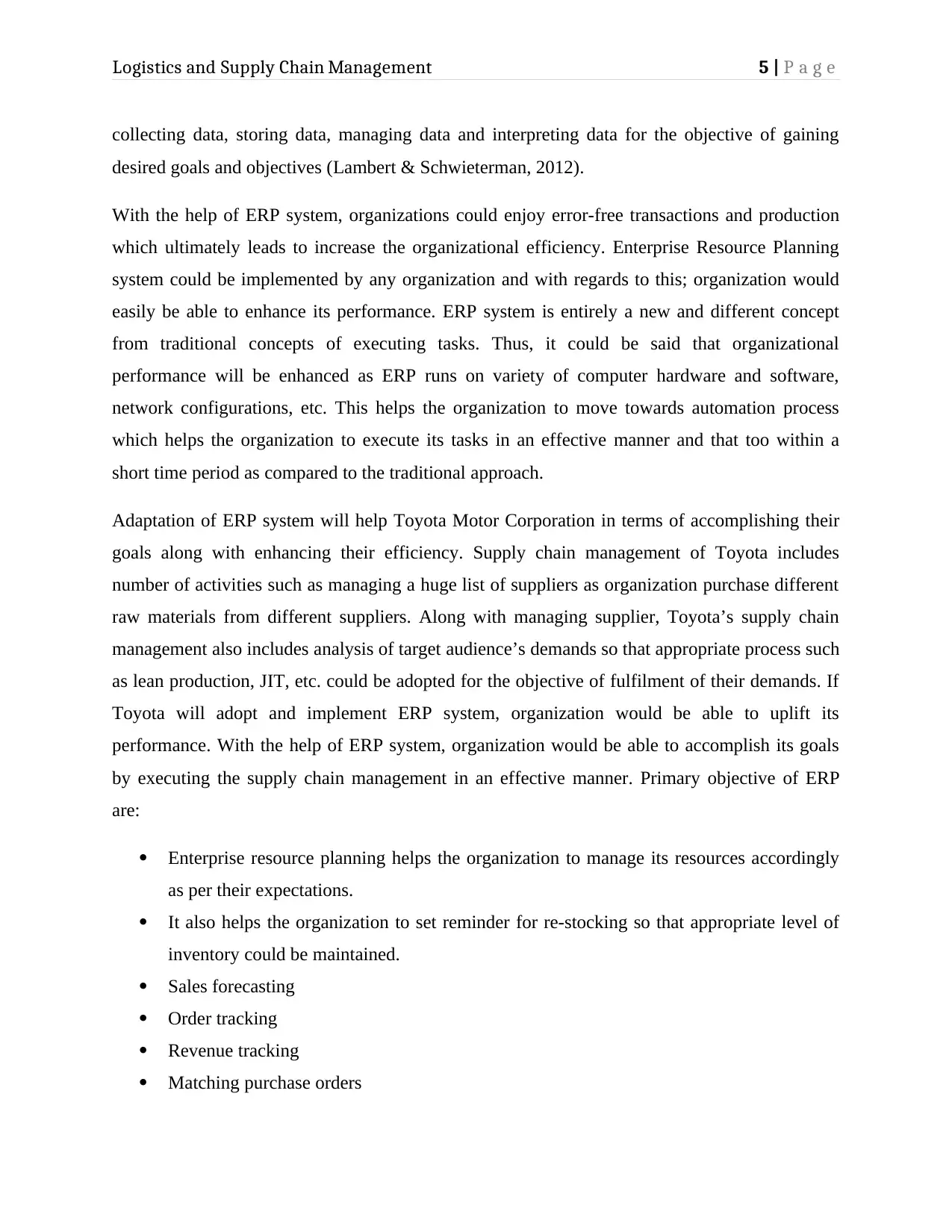
Logistics and Supply Chain Management 5 | P a g e
collecting data, storing data, managing data and interpreting data for the objective of gaining
desired goals and objectives (Lambert & Schwieterman, 2012).
With the help of ERP system, organizations could enjoy error-free transactions and production
which ultimately leads to increase the organizational efficiency. Enterprise Resource Planning
system could be implemented by any organization and with regards to this; organization would
easily be able to enhance its performance. ERP system is entirely a new and different concept
from traditional concepts of executing tasks. Thus, it could be said that organizational
performance will be enhanced as ERP runs on variety of computer hardware and software,
network configurations, etc. This helps the organization to move towards automation process
which helps the organization to execute its tasks in an effective manner and that too within a
short time period as compared to the traditional approach.
Adaptation of ERP system will help Toyota Motor Corporation in terms of accomplishing their
goals along with enhancing their efficiency. Supply chain management of Toyota includes
number of activities such as managing a huge list of suppliers as organization purchase different
raw materials from different suppliers. Along with managing supplier, Toyota’s supply chain
management also includes analysis of target audience’s demands so that appropriate process such
as lean production, JIT, etc. could be adopted for the objective of fulfilment of their demands. If
Toyota will adopt and implement ERP system, organization would be able to uplift its
performance. With the help of ERP system, organization would be able to accomplish its goals
by executing the supply chain management in an effective manner. Primary objective of ERP
are:
Enterprise resource planning helps the organization to manage its resources accordingly
as per their expectations.
It also helps the organization to set reminder for re-stocking so that appropriate level of
inventory could be maintained.
Sales forecasting
Order tracking
Revenue tracking
Matching purchase orders
collecting data, storing data, managing data and interpreting data for the objective of gaining
desired goals and objectives (Lambert & Schwieterman, 2012).
With the help of ERP system, organizations could enjoy error-free transactions and production
which ultimately leads to increase the organizational efficiency. Enterprise Resource Planning
system could be implemented by any organization and with regards to this; organization would
easily be able to enhance its performance. ERP system is entirely a new and different concept
from traditional concepts of executing tasks. Thus, it could be said that organizational
performance will be enhanced as ERP runs on variety of computer hardware and software,
network configurations, etc. This helps the organization to move towards automation process
which helps the organization to execute its tasks in an effective manner and that too within a
short time period as compared to the traditional approach.
Adaptation of ERP system will help Toyota Motor Corporation in terms of accomplishing their
goals along with enhancing their efficiency. Supply chain management of Toyota includes
number of activities such as managing a huge list of suppliers as organization purchase different
raw materials from different suppliers. Along with managing supplier, Toyota’s supply chain
management also includes analysis of target audience’s demands so that appropriate process such
as lean production, JIT, etc. could be adopted for the objective of fulfilment of their demands. If
Toyota will adopt and implement ERP system, organization would be able to uplift its
performance. With the help of ERP system, organization would be able to accomplish its goals
by executing the supply chain management in an effective manner. Primary objective of ERP
are:
Enterprise resource planning helps the organization to manage its resources accordingly
as per their expectations.
It also helps the organization to set reminder for re-stocking so that appropriate level of
inventory could be maintained.
Sales forecasting
Order tracking
Revenue tracking
Matching purchase orders
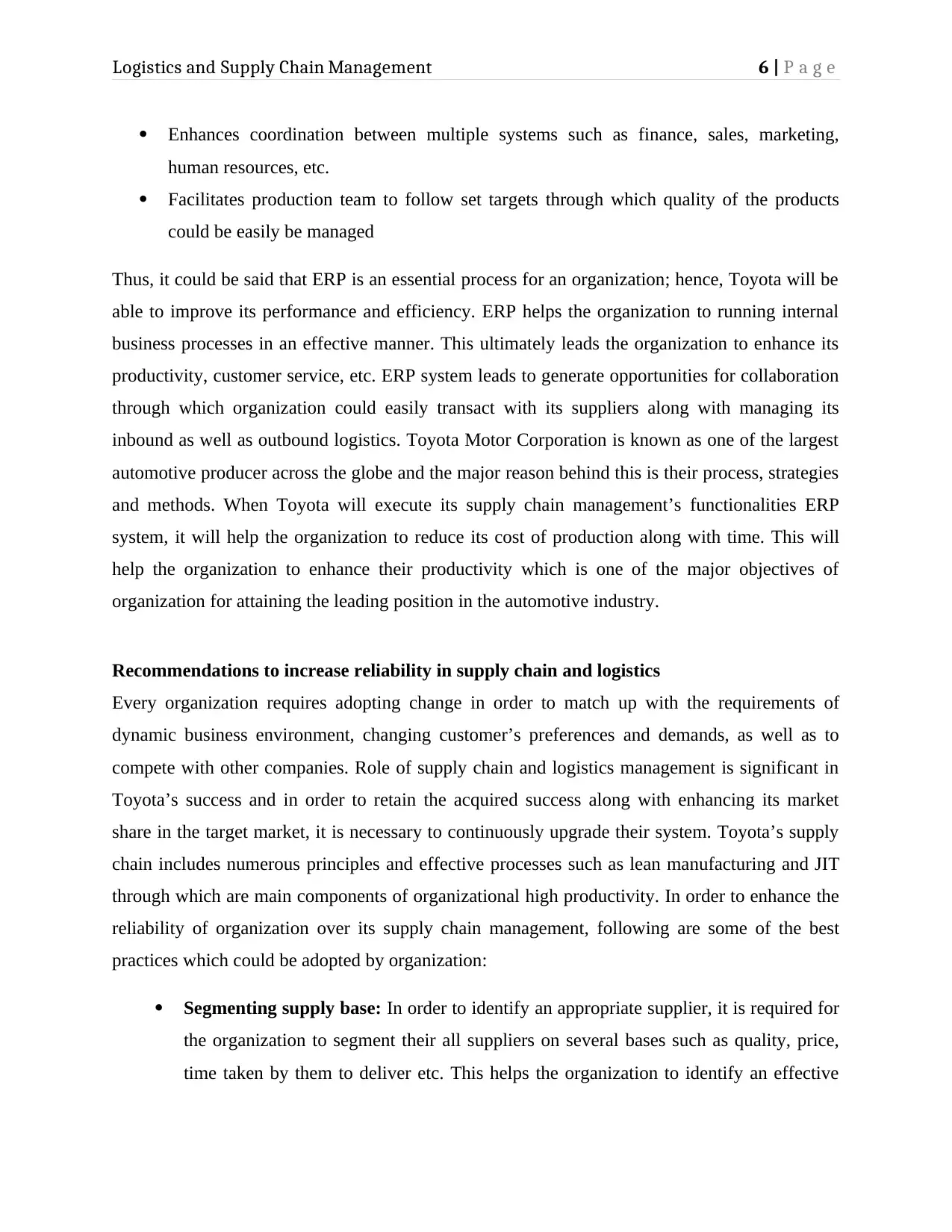
Logistics and Supply Chain Management 6 | P a g e
Enhances coordination between multiple systems such as finance, sales, marketing,
human resources, etc.
Facilitates production team to follow set targets through which quality of the products
could be easily be managed
Thus, it could be said that ERP is an essential process for an organization; hence, Toyota will be
able to improve its performance and efficiency. ERP helps the organization to running internal
business processes in an effective manner. This ultimately leads the organization to enhance its
productivity, customer service, etc. ERP system leads to generate opportunities for collaboration
through which organization could easily transact with its suppliers along with managing its
inbound as well as outbound logistics. Toyota Motor Corporation is known as one of the largest
automotive producer across the globe and the major reason behind this is their process, strategies
and methods. When Toyota will execute its supply chain management’s functionalities ERP
system, it will help the organization to reduce its cost of production along with time. This will
help the organization to enhance their productivity which is one of the major objectives of
organization for attaining the leading position in the automotive industry.
Recommendations to increase reliability in supply chain and logistics
Every organization requires adopting change in order to match up with the requirements of
dynamic business environment, changing customer’s preferences and demands, as well as to
compete with other companies. Role of supply chain and logistics management is significant in
Toyota’s success and in order to retain the acquired success along with enhancing its market
share in the target market, it is necessary to continuously upgrade their system. Toyota’s supply
chain includes numerous principles and effective processes such as lean manufacturing and JIT
through which are main components of organizational high productivity. In order to enhance the
reliability of organization over its supply chain management, following are some of the best
practices which could be adopted by organization:
Segmenting supply base: In order to identify an appropriate supplier, it is required for
the organization to segment their all suppliers on several bases such as quality, price,
time taken by them to deliver etc. This helps the organization to identify an effective
Enhances coordination between multiple systems such as finance, sales, marketing,
human resources, etc.
Facilitates production team to follow set targets through which quality of the products
could be easily be managed
Thus, it could be said that ERP is an essential process for an organization; hence, Toyota will be
able to improve its performance and efficiency. ERP helps the organization to running internal
business processes in an effective manner. This ultimately leads the organization to enhance its
productivity, customer service, etc. ERP system leads to generate opportunities for collaboration
through which organization could easily transact with its suppliers along with managing its
inbound as well as outbound logistics. Toyota Motor Corporation is known as one of the largest
automotive producer across the globe and the major reason behind this is their process, strategies
and methods. When Toyota will execute its supply chain management’s functionalities ERP
system, it will help the organization to reduce its cost of production along with time. This will
help the organization to enhance their productivity which is one of the major objectives of
organization for attaining the leading position in the automotive industry.
Recommendations to increase reliability in supply chain and logistics
Every organization requires adopting change in order to match up with the requirements of
dynamic business environment, changing customer’s preferences and demands, as well as to
compete with other companies. Role of supply chain and logistics management is significant in
Toyota’s success and in order to retain the acquired success along with enhancing its market
share in the target market, it is necessary to continuously upgrade their system. Toyota’s supply
chain includes numerous principles and effective processes such as lean manufacturing and JIT
through which are main components of organizational high productivity. In order to enhance the
reliability of organization over its supply chain management, following are some of the best
practices which could be adopted by organization:
Segmenting supply base: In order to identify an appropriate supplier, it is required for
the organization to segment their all suppliers on several bases such as quality, price,
time taken by them to deliver etc. This helps the organization to identify an effective
Paraphrase This Document
Need a fresh take? Get an instant paraphrase of this document with our AI Paraphraser
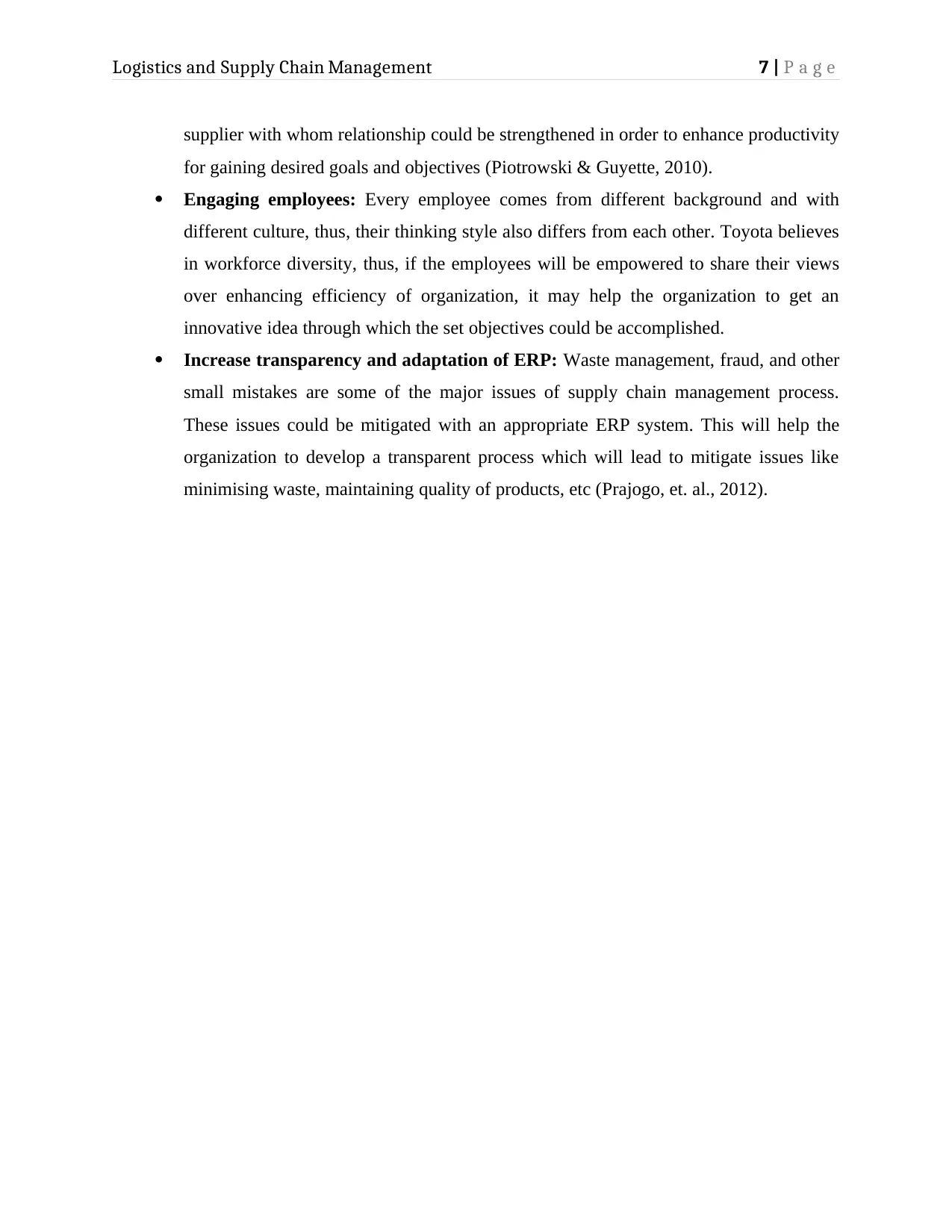
Logistics and Supply Chain Management 7 | P a g e
supplier with whom relationship could be strengthened in order to enhance productivity
for gaining desired goals and objectives (Piotrowski & Guyette, 2010).
Engaging employees: Every employee comes from different background and with
different culture, thus, their thinking style also differs from each other. Toyota believes
in workforce diversity, thus, if the employees will be empowered to share their views
over enhancing efficiency of organization, it may help the organization to get an
innovative idea through which the set objectives could be accomplished.
Increase transparency and adaptation of ERP: Waste management, fraud, and other
small mistakes are some of the major issues of supply chain management process.
These issues could be mitigated with an appropriate ERP system. This will help the
organization to develop a transparent process which will lead to mitigate issues like
minimising waste, maintaining quality of products, etc (Prajogo, et. al., 2012).
supplier with whom relationship could be strengthened in order to enhance productivity
for gaining desired goals and objectives (Piotrowski & Guyette, 2010).
Engaging employees: Every employee comes from different background and with
different culture, thus, their thinking style also differs from each other. Toyota believes
in workforce diversity, thus, if the employees will be empowered to share their views
over enhancing efficiency of organization, it may help the organization to get an
innovative idea through which the set objectives could be accomplished.
Increase transparency and adaptation of ERP: Waste management, fraud, and other
small mistakes are some of the major issues of supply chain management process.
These issues could be mitigated with an appropriate ERP system. This will help the
organization to develop a transparent process which will lead to mitigate issues like
minimising waste, maintaining quality of products, etc (Prajogo, et. al., 2012).
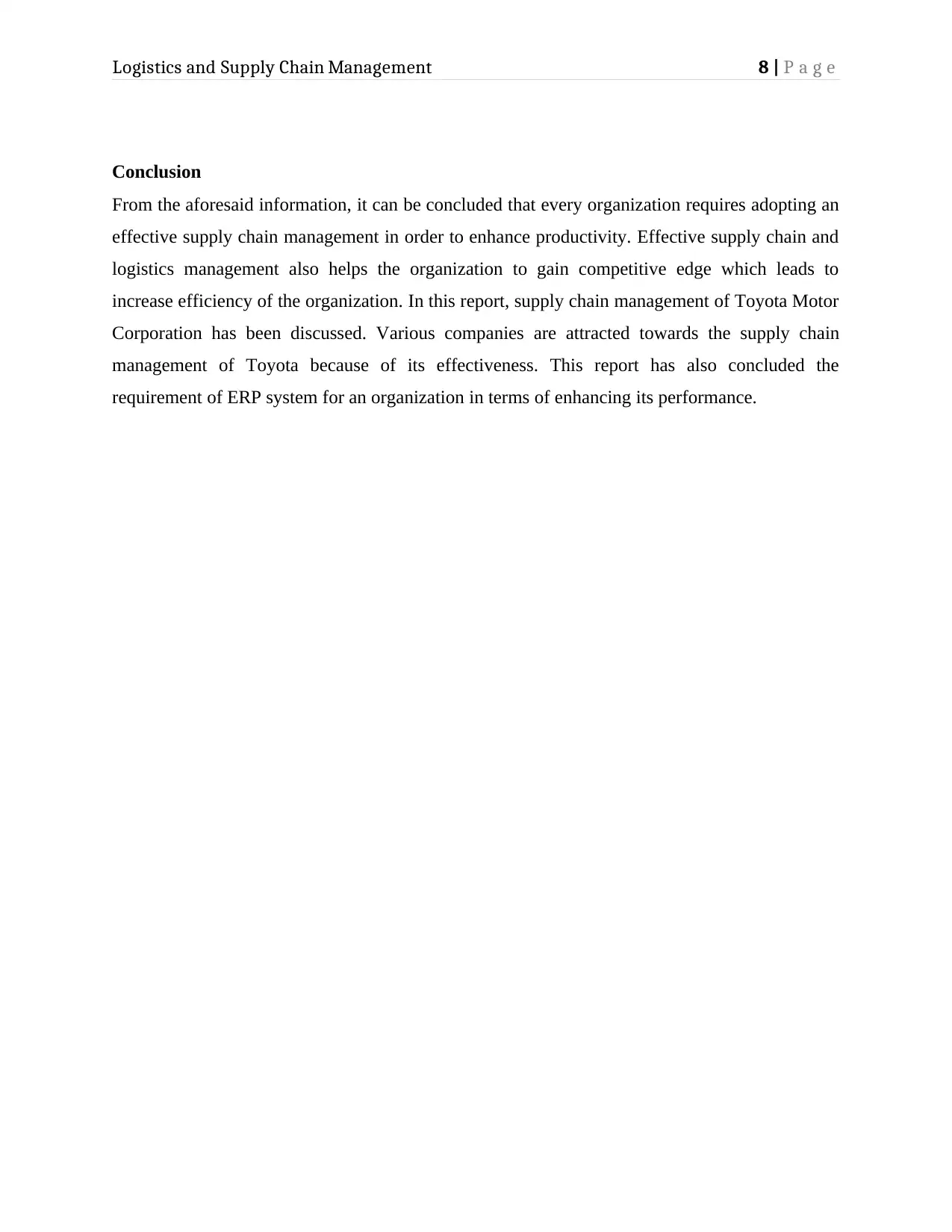
Logistics and Supply Chain Management 8 | P a g e
Conclusion
From the aforesaid information, it can be concluded that every organization requires adopting an
effective supply chain management in order to enhance productivity. Effective supply chain and
logistics management also helps the organization to gain competitive edge which leads to
increase efficiency of the organization. In this report, supply chain management of Toyota Motor
Corporation has been discussed. Various companies are attracted towards the supply chain
management of Toyota because of its effectiveness. This report has also concluded the
requirement of ERP system for an organization in terms of enhancing its performance.
Conclusion
From the aforesaid information, it can be concluded that every organization requires adopting an
effective supply chain management in order to enhance productivity. Effective supply chain and
logistics management also helps the organization to gain competitive edge which leads to
increase efficiency of the organization. In this report, supply chain management of Toyota Motor
Corporation has been discussed. Various companies are attracted towards the supply chain
management of Toyota because of its effectiveness. This report has also concluded the
requirement of ERP system for an organization in terms of enhancing its performance.
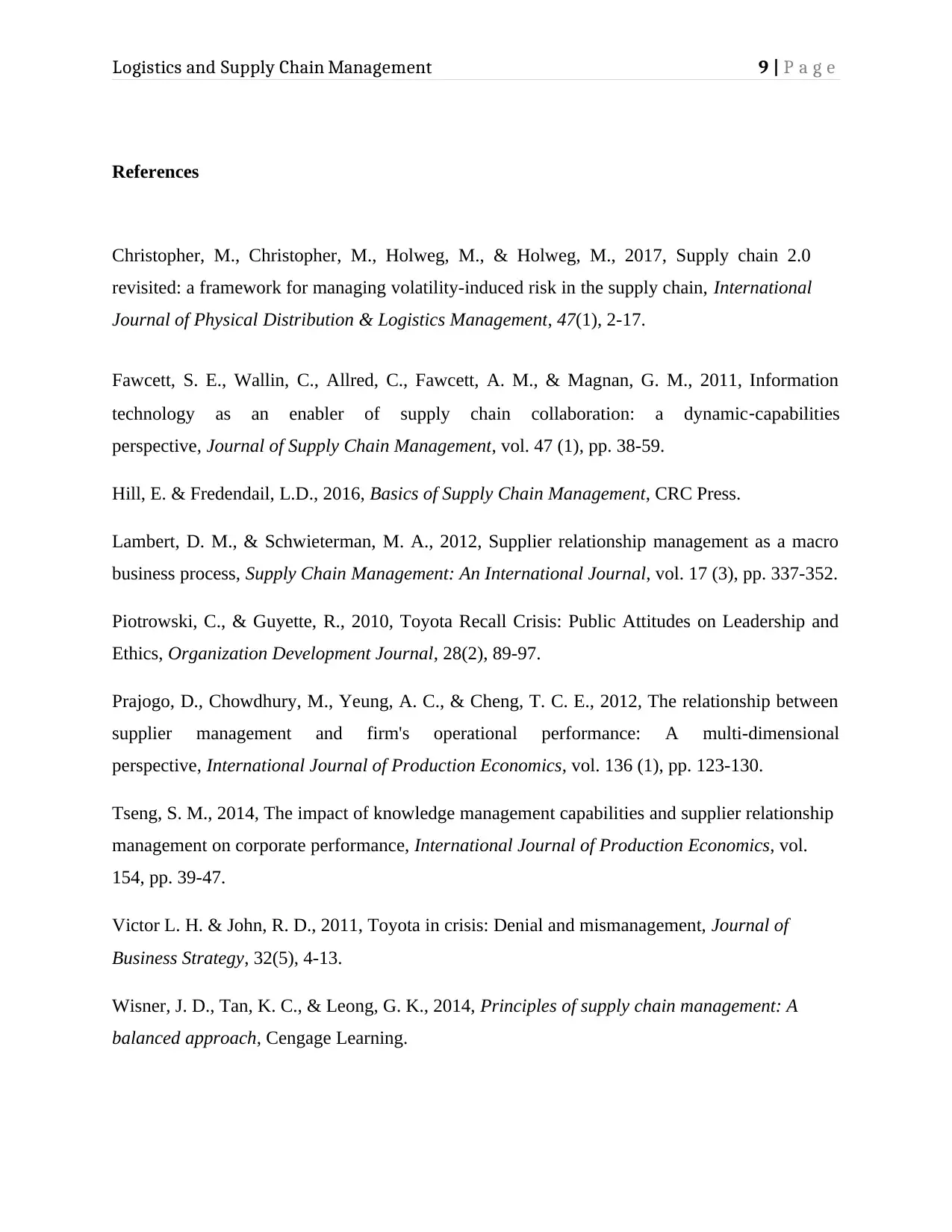
Logistics and Supply Chain Management 9 | P a g e
References
Christopher, M., Christopher, M., Holweg, M., & Holweg, M., 2017, Supply chain 2.0
revisited: a framework for managing volatility-induced risk in the supply chain, International
Journal of Physical Distribution & Logistics Management, 47(1), 2-17.
Fawcett, S. E., Wallin, C., Allred, C., Fawcett, A. M., & Magnan, G. M., 2011, Information
technology as an enabler of supply chain collaboration: a dynamic‐capabilities
perspective, Journal of Supply Chain Management, vol. 47 (1), pp. 38-59.
Hill, E. & Fredendail, L.D., 2016, Basics of Supply Chain Management, CRC Press.
Lambert, D. M., & Schwieterman, M. A., 2012, Supplier relationship management as a macro
business process, Supply Chain Management: An International Journal, vol. 17 (3), pp. 337-352.
Piotrowski, C., & Guyette, R., 2010, Toyota Recall Crisis: Public Attitudes on Leadership and
Ethics, Organization Development Journal, 28(2), 89-97.
Prajogo, D., Chowdhury, M., Yeung, A. C., & Cheng, T. C. E., 2012, The relationship between
supplier management and firm's operational performance: A multi-dimensional
perspective, International Journal of Production Economics, vol. 136 (1), pp. 123-130.
Tseng, S. M., 2014, The impact of knowledge management capabilities and supplier relationship
management on corporate performance, International Journal of Production Economics, vol.
154, pp. 39-47.
Victor L. H. & John, R. D., 2011, Toyota in crisis: Denial and mismanagement, Journal of
Business Strategy, 32(5), 4-13.
Wisner, J. D., Tan, K. C., & Leong, G. K., 2014, Principles of supply chain management: A
balanced approach, Cengage Learning.
References
Christopher, M., Christopher, M., Holweg, M., & Holweg, M., 2017, Supply chain 2.0
revisited: a framework for managing volatility-induced risk in the supply chain, International
Journal of Physical Distribution & Logistics Management, 47(1), 2-17.
Fawcett, S. E., Wallin, C., Allred, C., Fawcett, A. M., & Magnan, G. M., 2011, Information
technology as an enabler of supply chain collaboration: a dynamic‐capabilities
perspective, Journal of Supply Chain Management, vol. 47 (1), pp. 38-59.
Hill, E. & Fredendail, L.D., 2016, Basics of Supply Chain Management, CRC Press.
Lambert, D. M., & Schwieterman, M. A., 2012, Supplier relationship management as a macro
business process, Supply Chain Management: An International Journal, vol. 17 (3), pp. 337-352.
Piotrowski, C., & Guyette, R., 2010, Toyota Recall Crisis: Public Attitudes on Leadership and
Ethics, Organization Development Journal, 28(2), 89-97.
Prajogo, D., Chowdhury, M., Yeung, A. C., & Cheng, T. C. E., 2012, The relationship between
supplier management and firm's operational performance: A multi-dimensional
perspective, International Journal of Production Economics, vol. 136 (1), pp. 123-130.
Tseng, S. M., 2014, The impact of knowledge management capabilities and supplier relationship
management on corporate performance, International Journal of Production Economics, vol.
154, pp. 39-47.
Victor L. H. & John, R. D., 2011, Toyota in crisis: Denial and mismanagement, Journal of
Business Strategy, 32(5), 4-13.
Wisner, J. D., Tan, K. C., & Leong, G. K., 2014, Principles of supply chain management: A
balanced approach, Cengage Learning.
1 out of 10
Related Documents
Your All-in-One AI-Powered Toolkit for Academic Success.
+13062052269
info@desklib.com
Available 24*7 on WhatsApp / Email
![[object Object]](/_next/static/media/star-bottom.7253800d.svg)
Unlock your academic potential
© 2024 | Zucol Services PVT LTD | All rights reserved.




